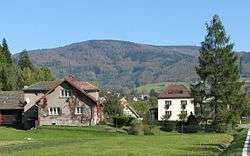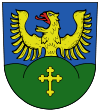Nýdek
| Nýdek Nydek | |||
|---|---|---|---|
| Village | |||
|
Hill Czantoria | |||
| |||
 Location in the Czech Republic | |||
| Coordinates: 49°39′21″N 18°46′26″E / 49.65583°N 18.77389°ECoordinates: 49°39′21″N 18°46′26″E / 49.65583°N 18.77389°E | |||
| Country | Czech Republic | ||
| Region | Moravian-Silesian | ||
| District | Frýdek-Místek | ||
| First mentioned | 1430 | ||
| Government | |||
| • Mayor | Jan Konečný | ||
| Area | |||
| • Total | 28.19 km2 (10.88 sq mi) | ||
| Elevation | 410 m (1,350 ft) | ||
| Population (2011) | |||
| • Total | 1,988 | ||
| • Density | 71/km2 (180/sq mi) | ||
| Postal code | 739 96 | ||
| Website |
www | ||
![]() Nýdek (Polish: Nydek , German: Niedek) is a village in Frýdek-Místek District, Moravian-Silesian Region, Czech Republic. It has a population of 1,952 (2001 census), 26.6% of the population are the Poles.[1]
Nýdek (Polish: Nydek , German: Niedek) is a village in Frýdek-Místek District, Moravian-Silesian Region, Czech Republic. It has a population of 1,952 (2001 census), 26.6% of the population are the Poles.[1]
It lies on the slopes of the Silesian Beskids mountain range, in the historical region of Cieszyn Silesia. Hluchová River flows through the village.
The name of the village is of uncertain origins and various explanations are expressed. One states it is derived from German Niedeck, another one that from personal name Nidek.[2]
History
The village was first mentioned in a written document in 1430 as Nidek.[2][3][4] Politically the village belonged then to the Duchy of Teschen, formed in 1290 in the process of feudal fragmentation of Poland and was ruled by a local branch of Piast dynasty. In 1327 the duchy became a fee of the Kingdom of Bohemia, which after 1526 became part of the Habsburg Monarchy.
After 1540s Protestant Reformation prevailed in the Duchy of Teschen and later local Lutherans built a wooden church here (it was not built earlier by Catholics). It was taken from them (as one from around fifty buildings) in the region by a special commission and given back to the Roman Catholic Church on 21 March 1654.[5]
The village with Lyžbice was bought from Joseph Freyherrn von Beess by Teschener Kammer in 1792 for 46,000 florins.[6]
After Revolutions of 1848 in the Austrian Empire a modern municipal division was introduced in the re-established Austrian Silesia. The village as a municipality was subscribed to the political district of Teschen and the legal district of Jablunkau. According to the censuses conducted in 1880, 1890, 1900 and 1910 the population of the municipality grew from 1,567 in 1880 to 1,747 in 1910 with a majority being native Polish-speakers (between 94.7% and 97.7%) accompanied by German-speaking (at most 74 or 4% in 1900) and Czech-speaking people (at most 17 or 0.9% in 1880). In terms of religion in 1910 the majority were Protestants (93.6%), followed by Roman Catholics (86 or 4.9%), Jews (7 or 0.4%) and 19 others.[7] The village was also traditionally inhabited by Cieszyn Vlachs, speaking Cieszyn Silesian dialect.
After World War I, fall of Austria-Hungary, Polish–Czechoslovak War and the division of Cieszyn Silesia in 1920, it became a part of Czechoslovakia. Following the Munich Agreement, in October 1938 together with the Zaolzie region it was annexed by Poland, administratively adjoined to Cieszyn County of Silesian Voivodeship.[8] It was then annexed by Nazi Germany at the beginning of World War II. After the war it was restored to Czechoslovakia.
Footnotes
- ↑ "2001 census data". Czech Statistical Office.
- 1 2 Mrózek, Robert (1984). Nazwy miejscowe dawnego Śląska Cieszyńskiego [Local names of former Cieszyn Silesia] (in Polish). Katowice: Uniwersytet Śląski w Katowicach. pp. 127–128. ISSN 0208-6336.
- ↑ Hosák et al. 1980, 151.
- ↑ Panic, Idzi (2010). Śląsk Cieszyński w średniowieczu (do 1528) [Cieszyn Silesia in the Middle Ages (until 1528)] (in Polish). Cieszyn: Starostwo Powiatowe w Cieszynie. p. 307. ISBN 978-83-926929-3-5.
- ↑ Broda, Jan (1992). "Materiały do dziejów Kościoła ewangelickiego w Księstwie Cieszyńskim i Państwie Pszczyńskim w XVI i XVII wieku". Z historii Kościoła ewangelickiego na Śląsku Cieszyńskim (in Polish). Katowice: Dom Wydawniczy i Księgarski „Didache“. pp. 259–260. ISBN 83-85572-00-7.
- ↑ Kaufmann, Aloys (2007). Gedenkbuch der Stadt Teschen (re-edition) (in German). 2. Cieszyn. p. 311. ISBN 978-83-914331-8-8.
- ↑ Piątkowski, Kazimierz (1918). Stosunki narodowościowe w Księstwie Cieszyńskiem (in Polish). Cieszyn: Macierz Szkolna Księstwa Cieszyńskiego. pp. 267, 285.
- ↑ "Ustawa z dnia 27 października 1938 r. o podziale administracyjnym i tymczasowej organizacji administracji na obszarze Ziem Odzyskanych Śląska Cieszyńskiego". Dziennik Ustaw Śląskich (in Polish). Katowice. nr 18/1938, poz. 35. 31 October 1938. Retrieved 1 July 2014.
References
- Hosák, Ladislav; Rudolf Šrámek (1980). Místní jména na Moravě a ve Slezsku II, M-Ž. Praha: Academia.
- Londzin, Józef (1932). Kościoły drewniane na Śląsku Cieszyńskim. Cieszyn: Dziedzictwo błog. Jana Sarkandra. pp. 213–216. OCLC 297540848.
External links
| Wikimedia Commons has media related to Nýdek. |
- (Czech) Official website




